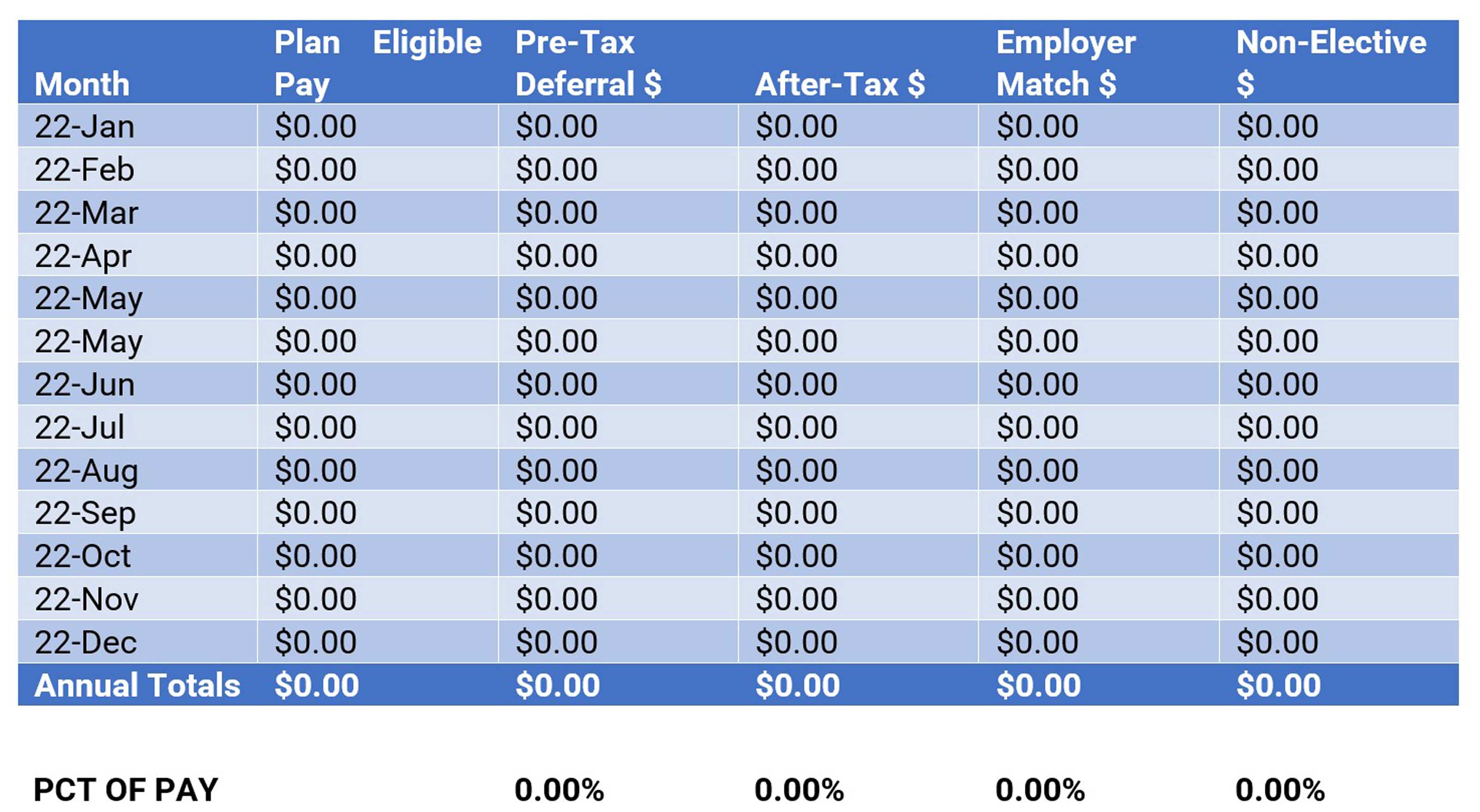When It Comes to Your 401(k), Trust But Verify
Few people review the accuracy of their 401(k) accounts. But mistakes do happen, so you should review your statements and paystubs just like you would your bank statements. Here’s what to watch out for.

Back when defined contribution plans first became popular in the mid-1980s, it was very common for quarterly statements to be distributed at worksites rather than mailed home. When statements were distributed, colleagues would often gather around to compare fund returns and question one another if anything looked amiss. I particularly recall being upset one quarter when my plan’s S&P 500 index fund significantly underperformed its benchmark. Then one of my colleagues pointed out that index funds are designed to mirror their benchmark as closely as possible, so any substantial differences in performance are likely to be a mistake and should be reported. It was, in fact, an error that I never would have caught if it hadn’t been for this casual conversation.
Now, many employees work remotely, and plan statements and confirmations are accessed electronically. For all the benefits of our digital age, we have lost the “crowdsourcing” of any issues or problems through co-workers taking 15 minutes to ask each other if everything seems accurate. There’s also a widely held belief among plan administrators that few participants review their accounts beyond checking their balance, given how long errors can go unchallenged. For example, I recently heard about thousands of participants having their contributions defaulted to the wrong fund for over 10 years without anyone noticing.
Where mistakes creep in
Let’s be clear: The overwhelming number of transactions recordkeepers manage daily are processed correctly, and fraud perpetrated against plan accounts is exceedingly rare. However, issues do periodically arise, particularly involving the calculation of plan contributions. Plan contributions not only involve the recordkeepers who account for your transactions, they also involve your company's payroll systems. And when errors occur, you might think your plan would simply make you “whole” for any mistakes. Unfortunately, this isn’t always the case. For instance, some correction efforts don’t extend to former employees who have already received a plan distribution. Also, administrators have some leeway to only correct accounts if the benefit to participants exceeds the cost of correction. And some plans have a stated policy that any errors must be reported within a specific time frame – typically three months – or your account is deemed correct.
From just $107.88 $24.99 for Kiplinger Personal Finance
Become a smarter, better informed investor. Subscribe from just $107.88 $24.99, plus get up to 4 Special Issues

Sign up for Kiplinger’s Free Newsletters
Profit and prosper with the best of expert advice on investing, taxes, retirement, personal finance and more - straight to your e-mail.
Profit and prosper with the best of expert advice - straight to your e-mail.
Considering you know your contribution and investment elections, you are in the best position to ensure the accuracy of your plan account. So, where should you begin? To start, here are some common issues that occasionally occur and how you can verify your account is accurate.
Depositing plan contributions
Even though plan deferrals may appear on your paycheck, there is an additional step involved to transmit those deductions to your plan recordkeeper for posting to the plan. And occasionally, errors can creep into this process. For example, an individual business unit may be omitted from the plan’s submission, or deductions from an off-cycle payroll (e.g., special bonus payments) may be omitted.
What you can do: Ask your plan administrator for a deposit schedule and go online to verify your contributions were credited in the stated timeline. The Department of Labor requires your own contributions be deposited by the 15th of the month following the payroll period, but most plans are required to deposit contributions on the earliest date that they can be reasonably segregated from the employer's general assets. (Unfortunately, some plans don’t have a fixed schedule but general guidelines.)
If you believe contributions are not being deposited timely and the issue isn’t being addressed by the plan administrator, you can contact the Employee Benefits Security Administration for assistance.
Plan compensation
Anyone who looks at a paycheck knows your compensation comprises multiple elements beyond base pay, such as bonus, overtime, sales incentives, etc. And plans differ in what pay elements are included in calculating plan contributions. What can sometimes happen is that a particular element of plan compensation – such as special bonuses or other pay types affecting only a select group of employees – are incorrectly overlooked in calculating plan contributions.
What you can do: First, you can find your plan’s definition of compensation in the Summary Plan Description. Then, multiply your plan eligible compensation by your deferral percentage and make sure it agrees with your plan contributions. The best times to do this are when you initially join the plan, when your pay increases, or when you receive any one-time or annual compensation payments, such as a bonus.
Employer matching contributions
The employer matching contribution formula in many plans is straightforward: A plan will match a percentage of employee contribution up to certain limits, e.g., 100% match on the first 5% of pay deferred as a contribution. But there can be added complexities to the process, such as allowing different deferral elections for regular salary and an annual bonus, a separate election for catch-up contributions (allowed for those 50 or older), or whether your pre-tax deferral election will “spill over” to after-tax contributions once you reach the annual pre-tax contribution limit ($20,500 in 2022).
What you can do: You can set up a sample template as shown below to total your actual contributions and compensation, calculate the percentage of pay you received in employer contributions, and verify you received the full amount due under the terms of the plan.

Take the example of a plan that matches 100% of pre-tax and after-tax contributions up to 6% of pay. You can use the spreadsheet above to verify that if the sum of your pre-tax and after-tax contributions exceeded 6% of plan compensation, you received 6% of pay in employer matching contributions.
There are legitimate cases based on the terms of your plan where you may not receive the full matching contribution under the plan if you vary your deferral percentage throughout the year. But even if no error was involved, this type of analysis can make you aware of the benefit of managing your contribution rate to receive the full matching contribution for the year.
The bottom line
The instances cited aren’t a comprehensive checklist but some factors to consider when reviewing your plan account. If you have any questions, contact your plan recordkeeper for an explanation as quickly as possible. (Remember, there are never any “stupid” questions about your money!) If you still aren’t satisfied, contact your HR or Benefits Department before your final recourse, which is to submit a formal appeal to the Plan Administrator as outlined in your plan’s Summary Plan Description.
Most people already review – at least occasionally – statements for their checking account, credit card, cellphone and internet service. Why not add your retirement plan balances to that list?
Profit and prosper with the best of Kiplinger's advice on investing, taxes, retirement, personal finance and much more. Delivered daily. Enter your email in the box and click Sign Me Up.
Alan Vorchheimer is a Certified Employee Benefits Specialist (CEBS) and principal in the Wealth Practice at Buck, an integrated HR and benefits consulting, technology and administration services firm. Alan works with leading corporate, public sector and multi-employer clients to support the management of defined contribution and defined benefit plans.
-
 Stocks Struggle for Gains to Start 2026: Stock Market Today
Stocks Struggle for Gains to Start 2026: Stock Market TodayIt's not quite the end of the world as we know it, but Warren Buffett is no longer the CEO of Berkshire Hathaway.
-
 Tip: Ways to Track Your Credit Card Rewards
Tip: Ways to Track Your Credit Card RewardsHere are the best strategies and apps to help you stay current with your credit card rewards.
-
 How New Investors Can Pick Their Perfect Portfolio, According to a Pro
How New Investors Can Pick Their Perfect Portfolio, According to a ProSee what Cullen Roche has to say about finding your perfect portfolio as a new investor and his two-word answer on where he thinks the stock market is headed in 2026.
-
 High-Net-Worth Retirees: Don't Overlook These Benefits of Social Security
High-Net-Worth Retirees: Don't Overlook These Benefits of Social SecurityWealthy retirees often overlook Social Security. But timed properly, it can drive tax efficiency, keep Medicare costs in check and strengthen your legacy.
-
 Do You Have an Insurance Coverage Gap for Your Valuables? You May Be Surprised to Learn You Do
Do You Have an Insurance Coverage Gap for Your Valuables? You May Be Surprised to Learn You DoStandard homeowners insurance usually has strict limits on high-value items, so you should formally "schedule" these valuable possessions with your insurer.
-
 8 Practical Ways to Declutter Your Life in 2026: A Retirement 'Non-Resolution' Checklist
8 Practical Ways to Declutter Your Life in 2026: A Retirement 'Non-Resolution' ChecklistHere's how to stop wasting your energy on things that don't enhance your new chapter and focus on the things that do.
-
 To Retire Rich, Stop Chasing Huge Returns and Do This Instead, Courtesy of a Financial Planner
To Retire Rich, Stop Chasing Huge Returns and Do This Instead, Courtesy of a Financial PlannerSaving a large percentage of your income, minimizing taxes and keeping spending in check can offer a more realistic path to retiring rich.
-
 New Year, New Retirement Rules: Here's How You Can Keep Up as the Landscape Changes
New Year, New Retirement Rules: Here's How You Can Keep Up as the Landscape ChangesFor a successful modern retirement, prepare for a longer life, manage high health care costs and prioritize your social life and purpose.
-
 7 Creative Ways to Spend Less and Save More In Retirement, Courtesy of a Financial Pro
7 Creative Ways to Spend Less and Save More In Retirement, Courtesy of a Financial ProWorried you won't have enough money later in life? Try redesigning your vision of retirement, and you may find your savings go further than you thought.
-
 I'm an Annuities Pro: This Is How You Can Cover the Income Gap While Your Social Security Benefits Grow
I'm an Annuities Pro: This Is How You Can Cover the Income Gap While Your Social Security Benefits GrowTaking Social Security later results in higher future income, but that can create an income gap. Annuities can boost income until you file for benefits.
-
 I'm a Financial Pro: You Really Can Make New Year's Money Resolutions That Stick (and Just Smile as Quitter's Day Goes By)
I'm a Financial Pro: You Really Can Make New Year's Money Resolutions That Stick (and Just Smile as Quitter's Day Goes By)The secret to keeping your New Year's financial resolutions? Just make your savings and retirement contributions 100% automatic.

